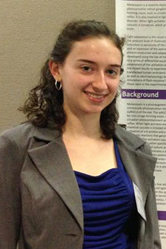Major: Biochemistry and Molecular Biology
Minor: Mathematics
“A Mathematical Model of Melanopsin Phototransduction and Light Adaptation”

Melanopsin is a recently discovered photopigment found in intrinsically photosensitive retinal ganglion cells (ipRGCs). It is involved in non-image forming vision, including circadian photoentrainment and the pupillary light reflex. It is also involved in light-related disorders, such as seasonal affective disorder. When light activates the photopigment, a phototransduction cascade commences, which produces an electrical signal that is sent to the brain. Light adaptation is the ability of the visual system to adjust its performance according to the ambient level of illumination. To describe melanopsin’s phototransduction and adaptation pathways, we developed a mathematical model by using the law of mass action to convert chemical equations describing the pathway to a series of differential equations that was solved with MATLAB. Model parameters of the activation and deactivation were determined by fitting the model results to experimental calcium imaging data collected from transfected human embryonic kidney cells expressing the melanopsin gene as well as electrophysiological data collected from ipRGCs. Mathematical simulations of the single flash response produce results consistent with those seen in the experimental data.
What research experiences have you had?
Since fall 2012, I have been participating in UMBC’s UBM program, which brings math and biology students together to work on interdisciplinary research projects.
How did you find the research opportunity?
I heard about UBM from a friend. I read the details on UBM’s website and submitted an application online.
Who did you work with on this project?
I am mentored by Dr. Phyllis Robinson (biology), Dr. Kathleen Hoffman (math), and Dr. Hye-Won Kang (math). I’m working on the project with another undergraduate, Jessica Ortega (math/biology double major). We’ve also had guidance from graduate students in the Robinson lab and UBM students who joined the program the year before us.
Was this your first research project?
Yes.
Do you get course credit for this work? Paid? How much time do you put into it?
I normally work 8 to 10 hours per week in the fall and spring, and I worked up to 35 hours per week last summer. This is a paid position and I have also received course credit.
What academic background did you have before you started?
I began at the beginning of my sophomore year, so my biochemistry background included lower-level biology, chemistry, and physics classes. I had also taken computer science and calculus, which were helpful since my research is very interdisciplinary, involving a lot of math and programming.
How did you learn what you needed to know to be successful?
I started by reading a lot of literature on the topic. Some graduate students taught us how to do the lab work during the summer. I learned most of the mathematical modeling techniques from previous UBM students and my mentors.
What was the hardest part about your research?
The hardest part is figuring out why our models do not work the way we expect and deciding how to improve them. In some cases, this is just checking and rechecking our programs for typos, other times it involves reconsidering our assumptions and deciding if any should be changed. It’s really important to be open-minded about making huge changes to the project.
What was the most unexpected thing?
I never expected to give so many presentations. My partner (Jessica) and I have done many oral and poster presentations at UMBC and at conferences elsewhere. My favorite was a math-biology conference at NIMBioS in Tennessee. I’m really glad I got to present so much, since my oral speaking skills have improved a lot.
What are your career goals?
I plan to pursue a PhD in chemistry with a focus in chemical biology.
What are you doing next for research?
This summer I’m participating in the SURF program at NIST.
What else are you involved in on campus?
I am a tutor the Chemistry Tutorial Center. I am also a member of the Honors College.
1/10/2024